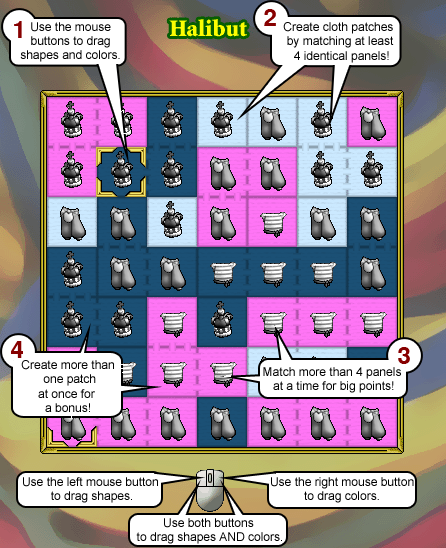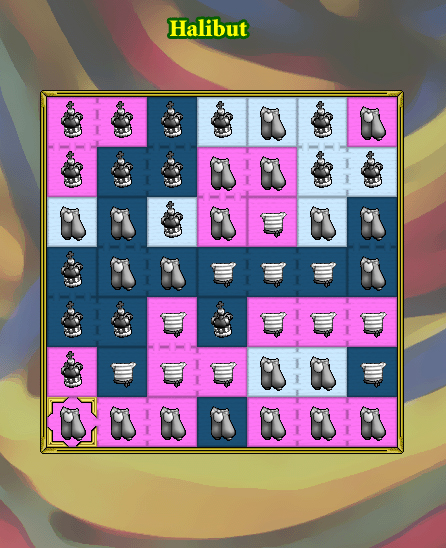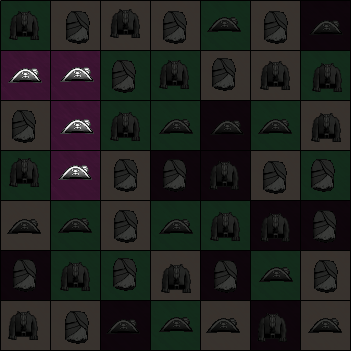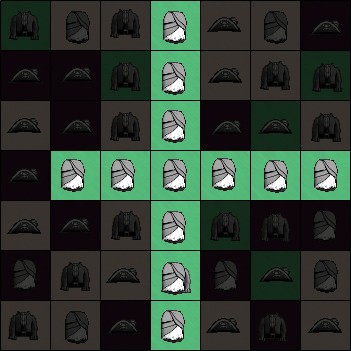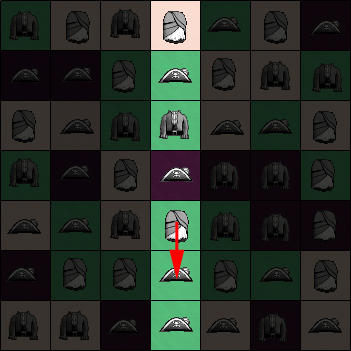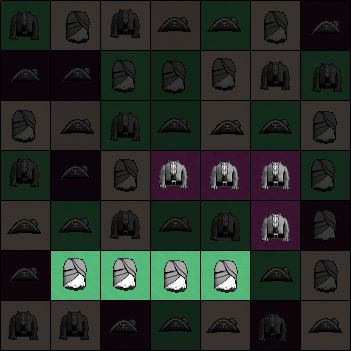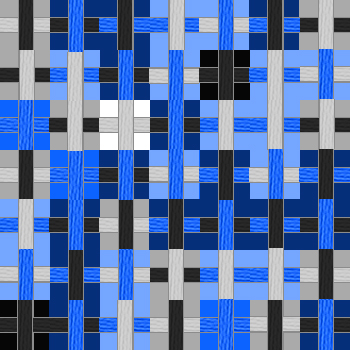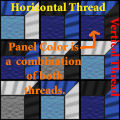GCPP:Proposal-Halibut
Puzzle Codename: Halibut
| Contact | |
| Username: | jdnx429 |
| Additional contact info: | danramarch@gmail.com
Skovran (Cobalt) - Programming |
| Project forum thread: | Discussion |
| A prototype is available for this proposal. | |
| Check it out and contribute to the design! |
| A game gardens puzzle is available for this proposal. | |
| Play it and help as a tester! |
Game concept
Similar to Chuzzle - but with two layers!
Quick Start
Objective
Move the colors and clothing pieces to match up 4 identical panels.
Gameplay
At the beginning of the game a board appears as shown below.
Each square has two layers - the color layer and the shape layer.
To move a color row or column, the player will click the right mouse button on a square and drag the mouse horizontally (row) or vertically (column). A shape row or column would be moved the same way but by the left mouse button. Colors and shapes can be moved together by pressing both mouse buttons simultaneously.
The player moves colors and shapes however he chooses- one square at a time or across the board and it will remain in that position. This is different from Chuzzle. In that game, if a move is not found by moving a row/column then that row/column is reset back to it's original position.
Once a match is made by having 4 identical panels adjacent to each other, the panels are cleared. This is called a patch. At that point, the panels above cleared rows fall down (first) and columns to the right are pulled left (second). New pieces then appear at the edges of the board. If a new match is found after the pieces are pulled inwards then those are cleared and so forth until the board contains no new patches. I think this will work similar to the way "uncontrolled clears" occur in Bilge.
Once 100 panels are cleared, the game ends.
An indicator, such as the roll of cloth in the picture will indicate progress through the game. As panels are cleared, the roll of cloths would move closer and closer to the right.
Examples of Moves
This is a patch - four identically colored panels with the same shape adjacent to each other.
This is an example of a larger patch - 12 panels. The shapes on the row are dragged to the left three panels and wrap around to the right. When the player lets go of the mouse button at the position shown, 12 identical panels become a patch.
This is an example of a combo - 2 patches. The shapes on the column are dragged down one position which makes 2 patches at once.
Scoring
Please note that these are just initial scoring guidelines and will most likely change after testing.
Moves
Points per move = -1 (Penalty) - (Decreases by -1 every 10 moves.) Thus, moves 1-9 are -1, moves 10-19 are -2, moves 20-29 are -3, etc...
Patches
Points for clearing...
4 panels = +8
5 panels = +15
6 panels = +20
7 panels = +30
8 panels = +45
9 panels = +65
10 panels = +90
11 panels = +120
12 panels = +160 (Likely maximum for one color clear)
Combos
Combos involve clearing multiple patches at the same type. Each patch will generally have a different color or shape but they could be identically colored with the same shape, as long as they are not connected.
As there are seven rows and seven columns, there can be up to seven different shapes/colors being cleared at once. The score for a combo is determined by adding up all the scores for each patch and multiplying them by this factor:
2 patches = x2.0
3 patches = x4.0
4 patches = x6.0
5 patches = x8.0
6 patches = x10.0
7 patches = x12.0
So for example, the combo as shown in the previous section is worth 60 points = 2.0 x (15 + 15)
(2.0x for clearing 2 patches at the same time.)
(15 points for each of the two patches.)
Cascade Clears
When patches are cleared, the panel pieces will move down. If the pieces fall into the position where they create more cleared patches, they will be cleared until no more are found.
These cascade clears will not count towards the 100 panels required to end the game. Additionally, they will be scored as shown above but multiplied by 0.25 for all subsequent clears. The reasoning for this is that cascade clears are mostly accidental and not very fun to build. This should encourage players to make large patches of cloth simultaneously. This is similar to bilge in which it's more fun to create Sea Donkeys and Bingo to set up chains.
Variability
Extra Pieces
None of the pieces will be occur on the intial board. These can only be made by playing well and bringing in more pieces.
Wild pieces that count as any shape or color. There can only be one of these at one time on the board, otherwise they lose their usefulness with accidental clears.
Buttons that would change one shape/color to another across the entire board. (See below for probabilites) To activiate the button the player will double-left-click on it to change shapes across the board, or double-right-click to change colors across the board. The game is then paused and a prompt will ask the player to click on two panels. The first panel will be the one that the player wants to change into. The second panel will determine which panels get changed.
For example, the player double-right-clicks on the Button to activate the color change across the board. The player clicks on the green panels then on the pink panels. All pink panels will then change to green.
After the panels are changed, checks are made for patches and scoring will proceed as if the player made a patch/combo and cascade. It is expected that a player could make higher level combos with this piece. Like the Wild Piece, only one piece Button would be available at a time.
Probabilities for Pieces
There will be at minimum 100 panels cleared - this means that there will also be at least 100 new panels. Some of those at the end of the game will not be playable since the game ends after the 100th panel is cleared.
Wild Pieces
These should occur about two or three times per game. Thus 1 in every 50 new pieces or 0.02 probability for each new piece. However, this probability should increase depending on the on the players score:
Probability = (0.02) + (Current Score/Scaling Factor)
The Scaling Factor dictates how difficult it will be for Wild Pieces to appear on the board. Right now it is assumed to be 2500, but will most likely vary as further testing is done.
Thus when a player has scored 250 points, the probablity for a new Wild Piece is (0.02 + 250/2500)=0.12 or 12%
However, see the discussion below for preventing many wild pieces ocurring at every clear for very high scores.
Buttons
Buttons would have a default probability of 0.00. Only after meeting a minimum score threshold would the probability start to increase. Once this point threshold is met, the probability for the Button piece would be determined by this function:
Probability = (0.02) + 0.5 * (Current Score/Scaling Factor)
Again the Scaling Factor here should be the same as for Wild Pieces and is also 2500, for now.
Thus when a player has scored 250 points, the probability for the Button piece is (0.02 + 0.5 * 250/2500)= .075 or 7.5%
However once the button has appeared, the score threshold for the Button piece must be raised, otherwise the possibility exists that new Buttons would occur after one is used. Thus, the player score is stored at the time when the Button appears and is substituted into the Function as follows (Button Score).
Probability = (0.02)+ 0.5 * (New Score/Scaling Factor)
Thus, the player will always have to put in some effort into obtaining the Button.
Extra Colors
The background colors could also be different every time the game is played, however there should be a light color, a medium color and a dark color to help people with colorblindness.
Examples of Light Colors:
Examples of Medium Colors:
Examples of Dark Colors:
End criteria
After 100 panels have been cleared, the game ends.
Difficulty scaling
Initially, there would be three colors and two shapes, on the standard difficulty levels this would be three colors and three shapes. Higher difficulties would have four colors and four shapes.
Crafting type
Tailor.
Known problems
Notes
Programming Notes
Proposed controls:
Left Mouse Button - Move/Drag Shape Layer
Right Mouse Button - Move/Drag Color Layer
Combined Mouse Buttons - Move/Drag Shape & Color
"R" - Pick up/Place down Shape & Colors
"F" - Pick up/Place down Shape Layer
"V" - Pick up/Place down Color Layer
"Left/Right" - Move Selected Layer Row "Up/Down" - Move Selected Layer Column
The initial program should have...
...only 3 colors and 3 shapes. (more can be added later)
...scoring capabilities to determine how many points were made by Patches, Combos and Cascades.
...a result screen showing how many Patches and Combos were made and what sizes they were, but should exclude those by Cascades. (This could be helpful for tailoring the scoring.)
...a tally showing how many new panels were made into the board.
Historical Notes
On the first pass of scoring and prototype testing, it was noticed that cascades were quite difficult to make. However, it seemed to be more fun to several large pieces of cloth simulatanously so the scoring was reflected to take advantage of that.
Orginally this was going to be a weaving proposal where colored thread pieces combined to create new colors, but I just could not figure out how to make this visually appealing. This was my last pass in trying to update it.
As you can see, it is still quite busy. Thus, this was changed to a Tailoring proposal.
